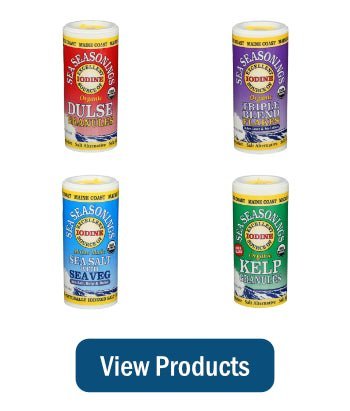The past few years have seen lots of media attention about “forever chemicals”, the latest in a long line of industrial chemicals to raise concern. If forever chemicals seem to be everywhere, it’s because they are. This has led seaweed lovers, including some of our own customers, to wonder whether they’re found in seaweed at dangerous levels. We think this is unlikely, but read on to learn more.
What are Forever Chemicals?
Forever chemicals are a family of over 4,500 manmade compounds technically known as per- and polyfluoroalkyl substances, or PFAS. Structurally, they all have carbon atoms linked to fluorine atoms, but there is a seemingly endless variety of ‘short-chain’ and ‘long-chain’ permutations of this basic structure, sometimes with other chemicals attached, and with new versions created every year. The carbon-fluorine bond is one of the strongest bonds known in nature, though it rarely naturally occurs. PFAS are known as forever chemicals because this bond makes them virtually indestructible and they persist in the environment for a very long time, which is why they are also known as persistent chemicals.

Image from pfasfacts.com
Other notorious persistent chemicals are PCBs (polychlorinated biphenyls) and CFCs (chlorofluorocarbons). PCBs were once used in electrical insulators, capacitors, and appliances and were even sprayed on dirt roads to keep the dust down until it was realized they were toxic to human health. PCBs were banned in 1979 but they continue to persist and cause problems. CFCs were used as a refrigeration and air conditioning gas until they were phased out in 1996 because they were destroying the earth’s protective ozone layer.
PFAS were first used in 1946 by Dupont to manufacture the non-stick cookware known as Teflon. Since then, their ability to repel both grease and water has made them useful in thousands of other consumer products such as food packaging, textiles, carpeting, upholstery, cosmetics, electronics, and even dental floss. They are also found in certain fire-fighting-foams, such as those used at airports. Like PCBs and CFCs, for many decades PFAS were considered safe until it became understood that some were actually toxic. During those decades they spread far and wide.

Image from Australian Department of Defence
How Toxic are Forever Chemicals?
Unless you’ve spent your life living off the grid in remote wilderness, you most likely have detectable levels of PFAS forever chemicals in your bloodstream. Even then, you may not be clear; PFAS have been found in the biota of remote Arctic regions. As early as 1968, it was understood that humans could accumulate organic fluorine in their blood serum. Organic fluorine is basically fluorine attached to carbon and it’s now recognized as indicating PFAS exposure. Improved test methods beginning in 1993 have confirmed this finding. Especially concerning is scientific evidence that PFAS bio-accumulates with prolonged exposure and that higher exposure leads to higher bioaccumulation. People become exposed through drinking water, cosmetics, clothing, household dust, and occupation. Studies show that occupational exposure can lead to blood serum levels as high as 1-2 mg per liter.
Through such knowledge researchers have carried out epidemiological studies where they examine the relationship between PFAS blood serum levels and various health conditions. The most extensive and well-known of these studies is the C8 Health Project, which investigated links between PFAS exposure and disease in people living or working in the vicinity of a Dupont Teflon manufacturing plant in the mid-Ohio Valley region. The study enrolled 69,030 participants and over the course of 6 years identified probable links between PFOA (a type of PFAS) and kidney cancer, testicular cancer, pregnancy induced hypertension, thyroid disease, high cholesterol, and ulcerative colitis. Other studies arrive at similar findings, but the strongest evidence is for toxic effects on immune function, particularly in children. High PFAS levels are correlated with weakened immune response to vaccination. Animal studies provide further evidence of the toxicity of some of these compounds.
The evidence is strong enough and concerning enough that in June, 2022 the EPA lowered its threshold advisory for levels of two particular types of PFAS in drinking water from 70 parts per trillion to 0.004 parts per trillion (PFOA) and 0.02 parts per trillion (PFOS). PFOA and PFOS are considered legacy PFAS because manufacturers phased them out beginning in 2006, but since they persist in the environment they will continue to cause problems for a very long time. Only a handful of legacy PFAS have been well studied for toxicity and phased out, but companies such as 3M continue to develop new versions. Although new PFAS chemicals are safety tested by manufacturers, we know relatively little about their long-term effects on health. This is why some public health advocates call for a ban on all PFAS, not just ones with known toxicity.
Are there PFAS in seaweed?
Forever chemicals are highly mobile in water, so it seems likely they eventually make their way to the sea. Studies conducted in parts of the Chinese Sea, the Bohai Sea, and the Pearl River Delta (all are coastal China), the Western Mediterranean Sea, and the Eastern coastal waters of the Red Sea have all detected PFAS. Levels ranged from barely detectable to as high as 4,700 ng/L (4.7 parts per billion) in the Bohai Sea. Other studies have detected PFAS in marine organisms such as plankton, shellfish, sharks, porpoises, and seals.
The Gulf of Maine has not yet been evaluated for PFAS contamination, but studies are underway. Maine Sea Grant recently announced a project headed by Cristoph Aeppli of the Bigelow Laboratory for Ocean Sciences titled Composition and transport of forever chemicals (PFAS) in Maine’s estuaries. The project includes field studies to measure levels of PFAS in coastal marine ecosystems and investigates how those chemicals make their way into estuaries. We will be sure to announce the findings in a future blog post as they become known.
The FDA concluded in June 2021 that PFAS exposure from food was not a human health concern, but studies evaluating seaweed for PFAS are virtually non-existent. A 2009 publication detected very low levels of <0.2 parts per billion in Fucus gardneri collected from Hudson Bay in 1999-2003 (Kelly et al., Perfluoroalkyl Contaminants in an Arctic Marine Food Web: Trophic Magnification and Wildlife Exposure, Environmental Science and Technology, 2009, 43(11):4037-4043). Regarding seafood in general, a 2020 study concluded that PFAS exposure from eating U.S. sourced seafood was of low concern (Ruffle et al., Perfluoroalkyl substances in U.S. market basket fish and shellfish, Environmental Research 190 (2020) 109932). Although PFAS were detected, levels were at or below single digit parts per billion.
The studies cited above are reassuring because they both show that seafood PFAS levels, whether it’s seaweed, finfish, or shellfish, are extremely low. However, fish from freshwater bodies known to be contaminated with PFAS have been reported to contain much higher levels. This makes intuitive sense, since the vast ocean offers far more dilution than ponds, lakes, or even rivers. For now, at least, it appears marine seafood is still mostly free of forever chemicals, but the situation needs to be monitored.
Does MCSV test seaweed for PFAS?
Maine Coast Sea Vegetables has not historically included PFAS as one of the many contaminants we test for. There are several reasons for this. The first is that, quite simply, PFAS contamination has only recently emerged as an issue of widespread concern. Like many, we thought it was largely a problem isolated to specific situations or regions, such as the mid-Ohio Valley region where the Dupont plant was located. However, in 2021 the issue hit close to home when we learned that some Certified Organic farms in Maine had been contaminated with PFAS through the spreading of waste sludge as fertilizer. Organic standards have long prohibited such use, but the sludge had been spread years before the farms changed ownership and became certified. In response, the State of Maine became the first state in the US, and the only region worldwide other than Germany, to totally ban this practice for all farms, organic or not. Maine is also the first state to start banning the use of PFAS chemicals in all products.
When we learned of this situation, we began a dialogue with our testing laboratory to see if we could have our seaweed tested as part of our annual screen. We found out that PFAS analysis is notoriously challenging. Not only does it require highly sophisticated equipment and methods, but it is prone to contamination because modern lab apparatus itself can contain various PFAS! Technicians can inadvertently contaminate a sample by using tubing that contains PFAS, for example. We’ve been hesitant to embark on a PFAS testing program because we’re not entirely confidant the methods are reliable yet, especially for a matrix as complicated as seaweed.
Given these complexities, it comes as no surprise that testing seaweed for PFAS is also far more expensive than the other testing we conduct. Despite the uncertainty and the cost, we intend to begin testing select seaweeds in 2023 (2022 harvest season). To our knowledge, this will make MCSV the first seaweed company anywhere to carry out PFAS safety testing. However, the cost means we have to be strategic to ensure meaningful test results without exorbitant expense, so for now we will just test rockweed and dulse. Rockweed was chosen because it is a brown seaweed that is widely distributed throughout the Gulf of Maine, and it grows close to shore, where it’s often exposed at low tide. Dulse was chosen because it is a red seaweed, popular with customers, and harvested from the northern Gulf of Maine in an area of low industrial activity and population density. Together, these two species should give us a good sense of all the products we sell harvested from two bio-regions. If we have confidence in the results, we will of course post and interpret them on our website. We will also stay current with the scientific literature to see if any new reports are published about PFAS in seaweed. Stay tuned!




